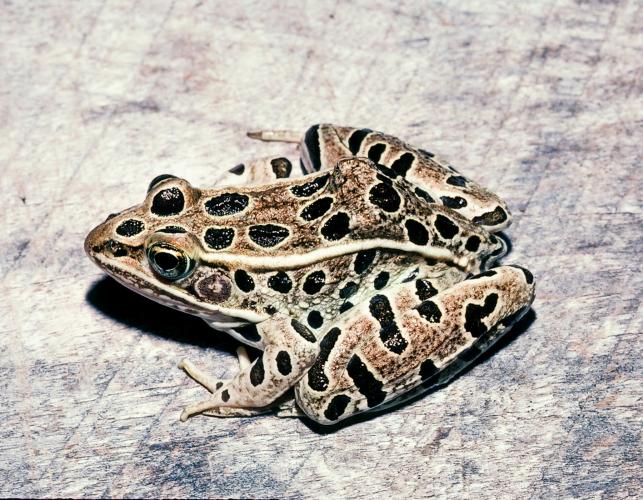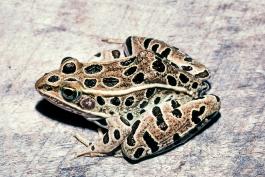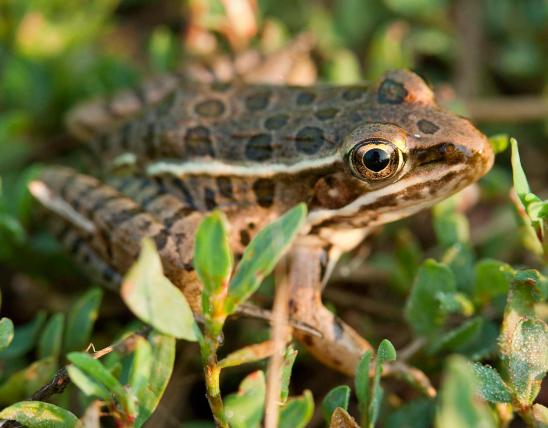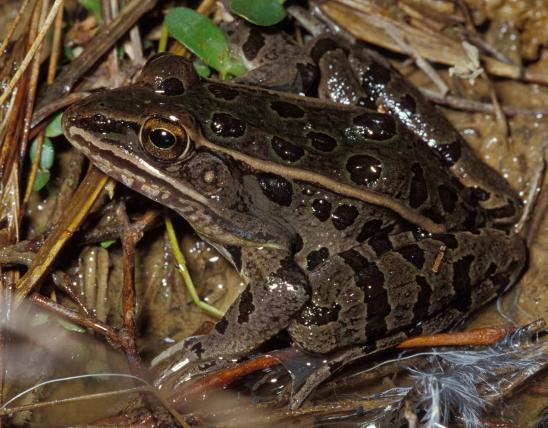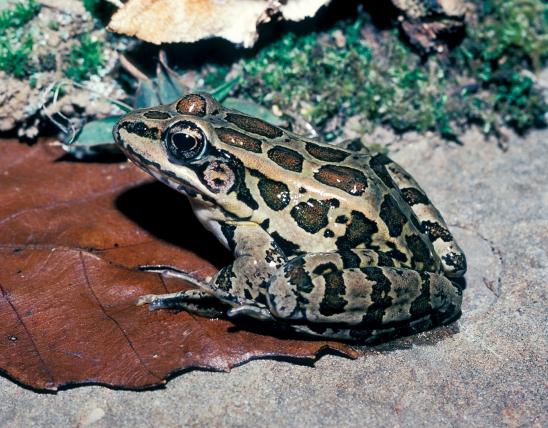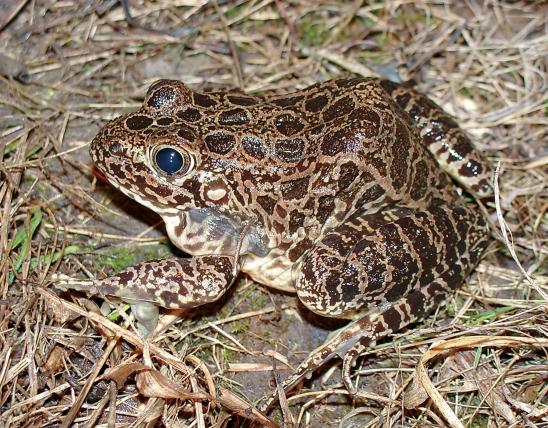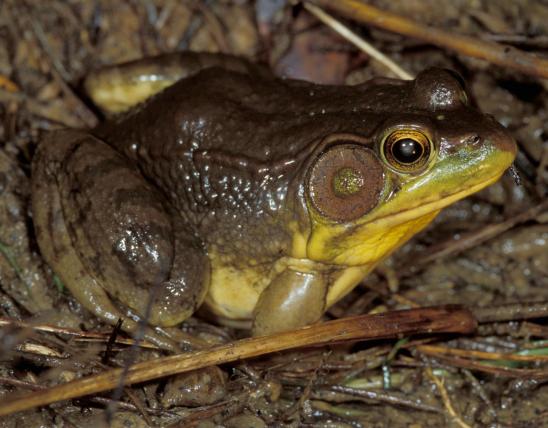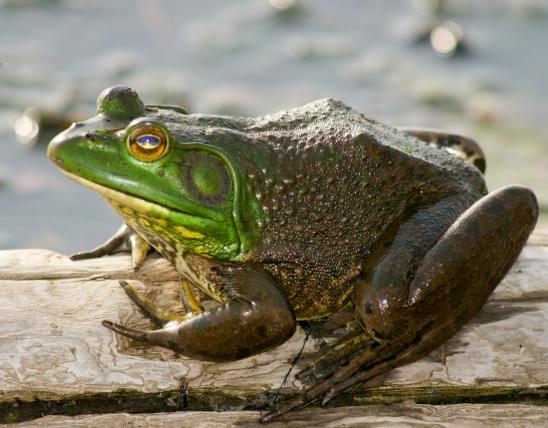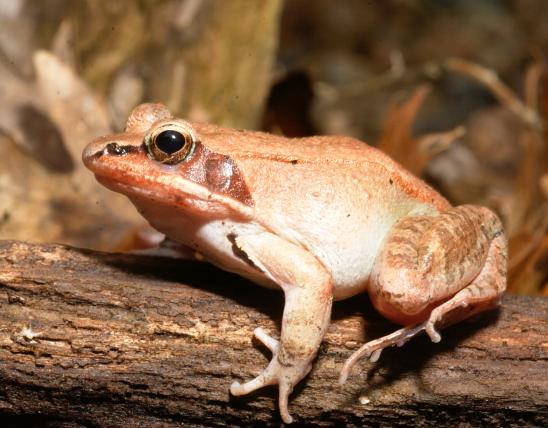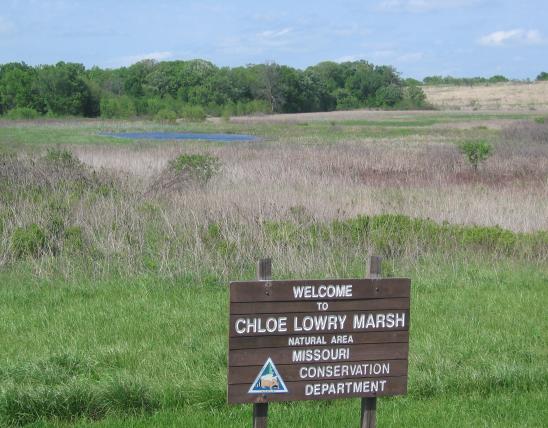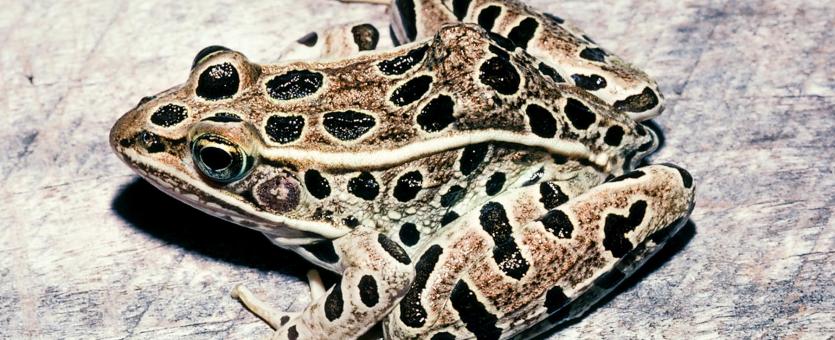
The northern leopard frog is medium-sized, with a brown or green ground color and, on the back, large, round, black or reddish-brown spots surrounded by light rings. The head is wide with a short, blunt snout. There is a prominent white line along the upper lip. Color of the tympanum (round external eardrum) is rusty brown; there is usually no light spot in the center. The skin folds along each side of the back are wide, run continuously to the groin, and are cream or tan. Dark spots along the back and legs are reddish brown to black, prominently ringed with white. The large round spots on the sides are black and are also ringed with white or pale green. The snout usually has a large round black spot. The belly is white. The groin area and the undersides of the hind legs are white or pale green.
Males make a deep, rattling snore with occasional clucking grunts, sounding like the sound of rubbing a wet thumb slowly along the surface of an inflated balloon.
Similar species: To distinguish northern leopard frogs from their lookalikes in Missouri, first, keep in mind their limited range in our state; then note that the southern leopard frog and plains leopard frog (L. sphenocephalus and L. blairi) do not have such a wide and/or continuous skin fold along the sides of the back, and they lack the distinct white rings around each dark spot.
Missouri has eight members of the true frog family. These are typically medium to large frogs with long legs, smooth skin, and well-developed webbing between the hind toes. Another common characteristic is a glandular fold or ridge of skin along each side of the back (these are called dorsolateral folds).
Adult length (snout to vent): 2 to 3½ inches; occasionally to 4½ inches.
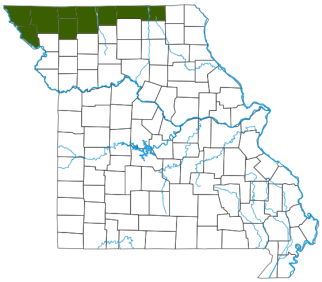
In Missouri, found only in a few northwestern counties along the Iowa border. Overall range includes Canada and the northeastern and north-central United States, extending into the Pacific Northwest and into Arizona and New Mexico.
Habitat and Conservation
This species is active from March to October. In its overall range in the northern and eastern United States and Canada, it lives in or near marshes, flooded ditches, floodplain pools and small ponds, and lakes, especially in grasslands and other open habitats. In Missouri, it can occur along the edge of small marshes and shallow drainage ditches.
Like other leopard frogs, it moves long distances to and from wetland breeding habitats and grassy areas in summer. In autumn, leopard frogs move to permanent water, where they can retreat to the bottom or into mud for the winter.
Northern leopard frogs are also called “meadow” or “grass” frogs because they often move into pastures and lawns during the summer.
Food
As with other leopard frogs, the northern leopard frog eats a variety of insects and spiders.
Status
This species was probably never abundant in our state. The northern leopard frog is a Missouri species of conservation concern due to its limited range, loss of habitat, and low population numbers. Preserving natural wetlands and surrounding grasslands is necessary for the long-term survival of this species and many other amphibians in northern Missouri.
The northern leopard frog and the plains leopard frog (L. blairi) both occur in the northwestern corner of the state. Studies of these frogs in northwestern Missouri, and one in Mercer County, have shown that the plains leopard frog, which has a wider range in our state, appears to be hybridizing with northern leopard frogs and causing the decline of this rare Missouri species due to genetic swamping. However, the populations of northern leopard frogs in Mercer County appear to have more genetic vigor and show little hybridization with the plains leopard frog.
This species was first discovered in our state in 1985 in Atchison County, and another population was found in 1987 in Mercer County. The northern leopard frog may be found in a few additional northern Missouri counties, given additional survey efforts.
Taxonomy: The true frog family (Ranidae) is the largest and most widespread family of frogs. It contains 365 species in 14 genera and probably originated in Africa. Representatives of this cosmopolitan family occur on every major land mass except New Zealand, Antarctica, most oceanic islands, the West Indies, and southern South America. The largest genus in the family in the New World (North and South America) is Lithobates (formerly Rana), with about 50 species. Missouri’s species, formerly in genus Rana, are all in genus Lithobates. As of taxonomic understandings in 2016, the Rana genus is considered restricted to the eastern hemisphere and western North America. In Missouri, the genus Lithobates is represented by eight species.
Life Cycle
In Missouri, breeding is in late March through mid-April; peak calling is usually in the first week of April. Beginning at dusk, males call from small areas of open water in marshes or shallow ponds, preferably clear-water wetlands. Eggs are laid in shallow water. A female may lay up to 6,000 eggs in globular masses attached to submerged sticks or vegetation. These hatch in 7–20 days, varying with water temperature. The tadpoles transform into froglets after 2–2½ months (in June to early July). Life span is estimated at 4–5 years.
Human Connections
As predators, these amphibians help decrease populations of many insects that are pests to humans. Additionally, their strange snoring, grunting choruses add to the magic of a Missouri evening.
The northern leopard frog is the official state amphibian of Vermont and Minnesota.
This species has been used for decades in research on nerve and muscle function.
Ecosystem Connections
Frogs are predators that help keep populations of insects and other small animals in balance. They, and especially their eggs, tadpoles, and young froglets, become food for both aquatic and terrestrial predators ranging from water bugs to fish to grackles to raccoons.
